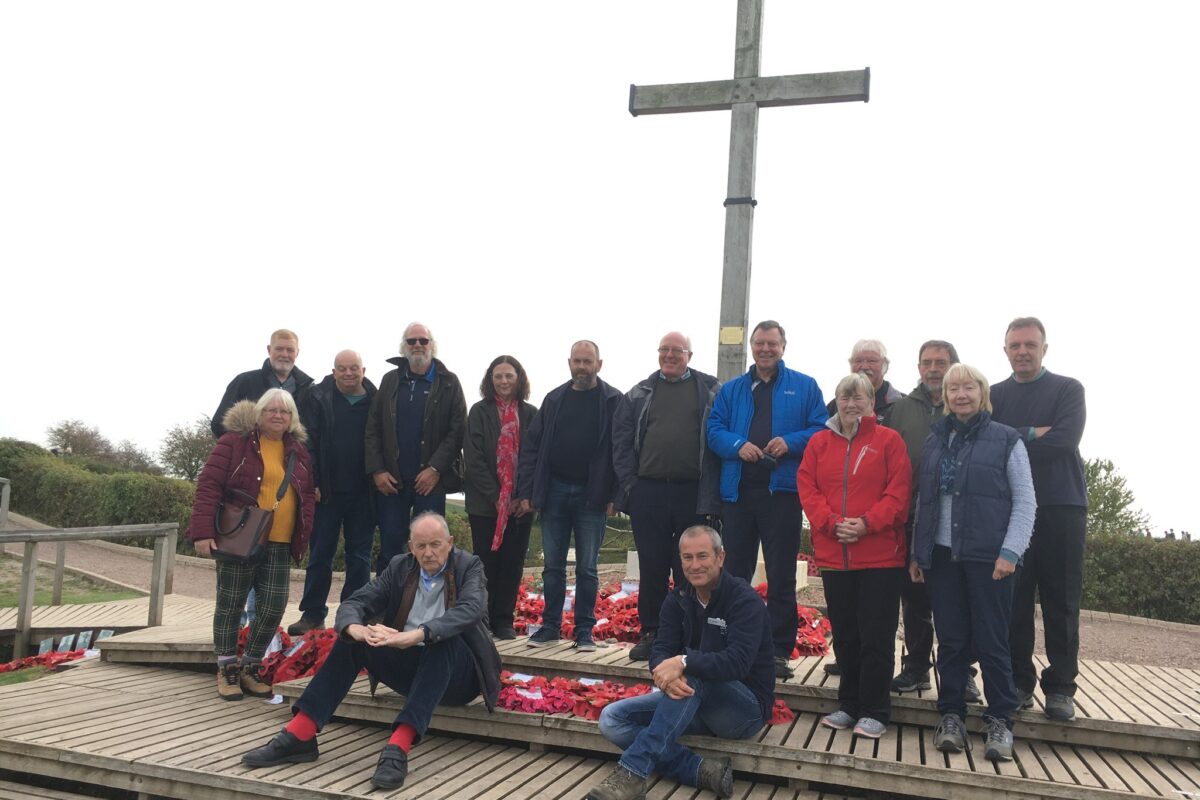
SENIOR BLUES | World War 1 Western Front Tour
On September 30th, a party of 15 Chester FC Senior Blues members left Chester in their tour bus at 5.55am for their long journey to the Western Front.
Senior Blues Chair Chris Courtenay Williams tells the story…
We arrived at our hotel in the Belgian border town of Mouscron later that evening.
The following morning we were greeted with torrential rain as we made an early start towards Ypres and to the Tyne Cot cemetery which is the largest British War Cemetery in the World. Obviously the scale and the amount of graves, made this place a very sombre visit, with the weather giving an idea of the type of conditions a lot of the poor men died in.
We stopped to see the “Brooding soldier” memorial to the Canadians who defended Ypres in 1915. Partially covered in scaffolding, as it was being cleaned at the time of the visit, it didn’t take away the majesty of this impressive statue.
Everywhere we went, all the memorials and cemeteries were in immaculate condition thanks to their constant care by the Imperial War Graves Commission.
We then visited the Langemarck German War cemetery and saw the spot where Adolf Hitler was photographed next to a gate when he visited the place in about 1941.
We than moved on and had lunch in a cafe/museum/shop in the village of Hooge.
We then moved onto Sanctuary Wood Trench Museum,and experienced walking in the preserved original trenches.
Then further on we travelled down the Messines Ridge to see the Ploegsteert memorial to the missing.
The day ended with a meal in Ypres and attending the nightly “Last Post Ceremony” at 8pm at the Menin Gate Memorial, which was a very moving experience.
Day Three started with another early start in fine weather and a visit to the Loos Battlefield on the “Forgotten Front” between Flanders and the Somme, visiting the Loos Memorial and “Dud Corner Cemetery”.
We had a very pleasant lunch in the lovely city of Arras before going underground in the Wellington Quarries to see where citizens and soldiers alike took shelter on the eve of the battle.
After a visit to the Arras memorial and paying respects to the Missing and seeing the Air Service memorial, we headed up to the spectacular Canadian Memorial on the top of Hill 145. Around this area where the memorial is, the ground is still pitted with shell holes from the bombardment the hill received before it was captured. Some areas are fenced off with warnings about “unexplored ammunition”, still after over 100 years.
Our last day dawned again fine and sunny, and we were now travelling into the heart of the Somme battlefields. Our first visit was to the “Lochnagar Mine Crater” at La Boisselle , where thousands of pounds of explosives were set off under German lines, in the prelude to “Going over the top” on July 1st 1916. Even after erosion etc. and after over 100 years, it is an enormous crater. Now privately owned ( to preserve it) you are not allowed to go in it, but the size alone tells its own story.
We then moved on to the Newfoundland park, a dedicated battlefield fought on so bravely by the Canadian army. Beautifully lawned and manicured, it didn’t disguise the numerous trenches still to to be seen quite clearly, with metal stakes and spikes and barbed wire still in place.
We then went on to the fairly new Somme Museum, the “Historial de la Grand Guerre” in Peronne. This museum really needed a day on its own. With everything associated with the Somme battle on show from uniforms to artifacts, weapons and continuous film shows throughout the museum,also a very well stocked with books “souvenirs” etc.
Set in a beautiful lakeside location it was a very impressive place..
Our final visit was to the almost overwhelming edifice of the “ Thiepval Memorial to the missing” with the names of over 17,000 men “without a known grave” set into it. A very moving and apt conclusion to our tour.
Walking away from the Thiepval Memorial I strayed slightly into a newly ploughed field, I looked down and spotted a small metal ball, it was piece of schrapnel that had been lying there for over 100 years. Of course, First World War Artifacts surface every day on these fields, local shops and museums etc in the area are packed with anything from guns, grenades to buttons and bullets and buckles.
Come Friday, an uneventful, but long trip back to Blighty.
This has been a person recollection. Apologies, if I have missed anything out to those who came! The were other cemeteries and landmarks all over the Somme, some we visited just briefly. You could not travel very far without coming across a little cemetery in the corner of field, some with hundreds of graves, one with just eleven men in it.
How true the poem “In the corner of a foreign field.”
Chris Courtenay Williams.




